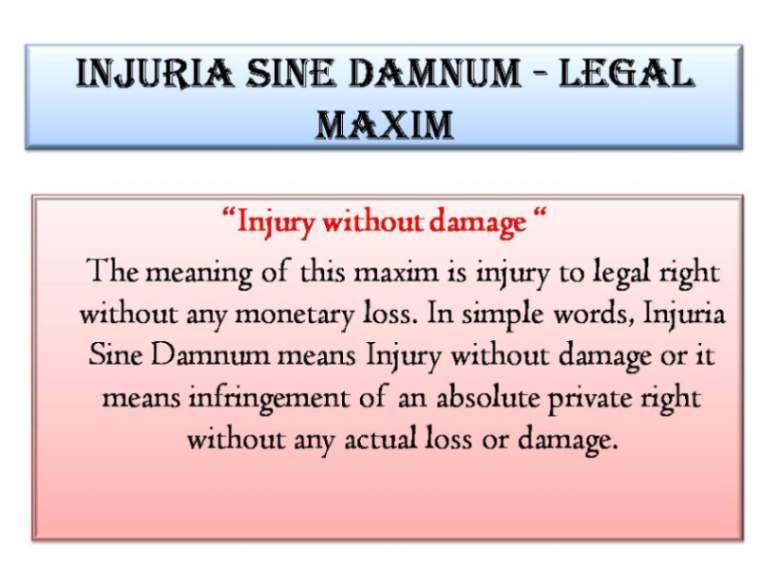About
The term maxim relates to well-known prepositions & principles. This is the overall system of regulations, concepts, or norms that the general public should follow. Maxims are helpful since they enable a particular point of law to be comprehended quickly and clearly, and they can also be used to resolve cases properly.
Maxims are frequently applied in a variety of legal fields, also including tort law.
Damnum Sine Injuria

Damnum Sine Injuria refers to “injury or damage in terms of the money, property, and assets, or any physical damage that generally occurs without breach of any lawful right.” However, if the action was malicious and committed to cause injury to anyone but without violating the person’s legal rights, it is not actionable in law.
Damnum Sine Injuria”…SALMOND
A person who merely exercises his or her rights, as is the case of lasses imposed by a trade competition on individual traders; or –
A person in the case of the defendant exercising his/her rights of ownership; or
Where damage is caused by a man acting more than what is required to prevent further damage;
The harm complained about may be too indefinite or too trivial to provide evidence to be recognized effectively. Therefore, with no action, it appears that damage will be recovered for just physical harm without any accompaniment. However, caused by a deliberate act or by the defendant’s negligence.
Likewise, damages may be legal. No right to pecuniary compensation could be granted to the injured party but provided for. Certain other remedies, such as criminal prosecution, if applicable. This is the case, for example, Damage suffered by an individual common with the public due to the existence of a public nuisance.
Landmark cases of Damnum Sine Injuria
The preceding principle can be further elaborated with the assistance of some leading case laws-
Gloucester Grammar School (1410)
The respondent, in this case, was a former teacher at the plaintiff’s school who quit after a fistfight and opened a new school in the neighborhood nearby. Because of the teacher’s popularity, many students followed in his footsteps and enrolled at his rival school. As a consequence, the plaintiff suffered financial losses, and a suit for payment of compensation was filed in court. The issue before the aforementioned court here is whether the respondent could be held responsible under the doctrine of ‘Damnum sine Injuria.’
Furthermore, the respectable court ruled that no monetary compensation can be granted, even though the plaintiff had suffered compensatory damages, due to the lack of evidence of a violation of legal rights. Moreover, the respondent was within his basic legal rights to establish and maintain a school, & the act didn’t infringe the plaintiff’s rights. Economic losses incurred as a result of the respondent’s actions cannot be regarded as an encroachment of legal rights.
Mayor&Co of Bradford vs. Pickles (1895)
The Bradford Corporation was supplying water from its own well. Defendant (Pickles) held adjacent land to the area from which the Bradford Corporation was providing water & had dug a well. The respondent immediately informed the Bradford Corporation that he was interested in selling his property to them. To discuss the situation, he contacted the Mayor of the Bradford Corporation. However, the meeting was failed.
The Corporation of Bradford claimed that the defendant built a well on his own property, severing the corporation’s underground water supply. Because there was no appropriate supply of water to distribute to the people who resided under the Corporation’s control, the corporation suffered a financial loss.
Pickles was sued by the Corporation of Bradford for damages caused by malice. It was held that the defendant is not accountable since the defendant’s conduct was not unlawful because it did not infringe on the plaintiff’s legal rights (Corporation of Bradford). The act of the defendant or conduct was unneighborly, but the court found no cause of action against him because he had not infringed on the plaintiff’s rights.
Action vs. Reuter’s Telegraph Company
The defendant carrying on mining operations on his land drained away from the percolating water from the land of the plaintiff and thus dried up the plaintiff’s well. No action has been held; it can be dug and applied to a person who owns the surface.
Everything that can be found there for his own sake at his discretion and when the water is collected from underground springs in the neighbor’s wall in the exercise of that right. This discomfort to her neighbor fits within the concept of terrible abseque injuries that cannot be the basis for action.
Vishnu Dutt Sharma’s case
Vishnu Dutt Sharma vs. Board of High School & Intermediate Education AIR 1981
The plaintiff in the case was a student who was unlawfully detained by the principal due to a misinterpretation of the regulatory requirements due to a lack of attendance. The plaintiff filed a lawsuit, claiming that he was entitled to damages because he had suffered serious a one-year loss. The court ruled that the plaintiff could not seek compensatory damages because a misinterpretation of rules & regulations doesn’t constitute Tort.
The final decision not to hold the defendant accountable for constructing a competing school opposite the appellant was correct in the case of Gloucester Grammar School. Students in the appellant’s school preferred the defendant’s teaching methods, and it was their own choice which institution they wanted to join to study.
Furthermore, the appellant also couldn’t restrain the defendant from operating a school because it is his right to conduct a perfectly legal business with his knowledge or permission.
Injuria Sine Damnum

INJURIA SINE DAMNUM denotes infringement of the law without prejudice. A violation of legal rights if a person is held liable for prosecution, whether or not that person causes actual damage or loss to the plaintiff.
Injuria refers to an infringement of the legally protected interest (i.e., right). SINE is an abbreviation for “without” or “absent.” It means the same as ‘obseque.’ And the term ‘DAMNUM’ refers to actual physical loss, whether in terms of health, comfort, money, or service.
Landmark cases of Injuria Sine Damnum
The preceding principle can be further elaborated with the assistance of some leading case laws-
Ashby vs. White (1703)
In Dec 1701, a shoe cobbler named Matthew Ashby came up to vote in the UK Parliament. William White, a police officer, turned Ashby away, claiming that “he has been no settled inhabitant/resident of the city, and had never contributed significantly either to churches or to the poor and needy.” Despite this, his candidate won the election, and he was not harmed. Although Ashby wasn’t going down without a fight, he filed the litigation for significant damages.
The defendant argued that he was not liable because his party had won the election and Ashby had suffered no damage. The lawsuit filed by the plaintiff was granted. The views of Ashby were upheld by Lord Holt C.J., who argued that what was at dispute was “a most transcendent matter and of a high basic nature.”
Subsequently, it was determined that the respondent (White) infringed Ashby’s legal right to cast a vote by preventing him from voting & that he was entitled to loss or damage.
Applicant’s vote was falsely suppressed by Respondent, a prominent official in a congressional election. Despite this, the applicant is not affected by the rejection because the candidate for whom he wished to vote won. Thus According to C.J. Holt, “every injury or harm causes damage, even if that doesn’t cost the party a farthing.” As a result, the defendant is entitled to pay the plaintiff’s damages.
Bhikhi Ojha vs. Harakh Kandu
The facts were that the Maharaja of Dumraon and his predecessors have had a monopoly on the weight since time immemorial. The goods and products are sold in a bazaar which helps their land and claims all the balance charges on those transactions that have taken place. There, instead of collecting rents from merchants for land use. Maharajah gave the plaintiff the exclusive right to weigh and collect weighing fees in the bazaar.
It is alleged that the plaintiff brought an action for damages for unlawful interference with the right to weigh. And the collection obstruction is maintainable. But the proof of this real damage is essential. Straight, j., Comments: “It is clear that the Applicant is possessive. This right and right were violated by the defendants causing pecuniary loss (damages). And the damage caused by the actions of these defendants, in my opinion, you have the right to continue this case and possibly recover the damages that the plaintiff may have suffered”.
In the event of a breach of the law, the one whose right has been infringed is free to launch a lawsuit per Section 34 of the Specific Relief Act, 1963
Bhim Singh v. State of Jammu & Kashmir
In this instance, Bhim Singh was a member of the J&K State Legislative Assembly who was detained by state police while on his way to a legislative assembly vote and detained indefinitely without charge.
His wife filed a Habeas Corpus petition to gain his malafide release. Following an investigation, it was discovered that the MLA was not brought before a court within the legal timeframe of 24 hours following his detention and that the police had illegally obtained the arrest warrants under suspicious circumstances, implying police complicity with competing political parties.
The apex Court determined MLA Bhim Singh’s democratic right & awarded him Rs. 50,000 in compensatory losses. In addition, the appropriate police official was penalized for neglect of duty and misconduct.
Distinction between damnum sine injuria and Injuria sine damnum
| Damnum Sine Injuria | Injuria Sine Damnum |
| 1. It simply refers to the plaintiff’s damages however there is no infringement or violation of the plaintiff’s legal rights. | 1. It is a lawful injury or harm caused to the plaintiff that does not result in physical harm or damage. |
| 2. The concept of this maxim is that an individual exercising within reasonable boundaries does not give rise to a tort action simply because it causes harm to others. | 2. The basic concept of this maxim is that whenever a legal right is violated, a cause of action is created, and the individual whose right is infringed is entitled to take legal action. |
| 3. It is the loss suffered without the infringement or violation of any lawful right, creating no cause of action. | 3. It is an infringement of a legitimate right that creates a legally actionable cause of action even if the plaintiff suffers no loss. |
| 4. This maxim applies to moral wrongs that have no legal consequences. | 4. This old maxim applies to legal wrongful acts that are ascertainable if a person’s legal right is infringed. |
| 5. The court does not award any monetary compensation. | 7. Damages that do not result in injury aren’t legally actionable. |
| 6. In this case, the complainant suffers a loss or damage but suffers no legal harm or damage. | 6. In this case, the plaintiff suffers legal harm or injury regardless of whether or not they have suffered any loss as a result of it. |
| 7. Damages that do not result in injury aren’t really legally actionable. | 7. This is ascertainable because a legal right has been infringed. |
Conclusion
The two maxims conclude that one is a moral error that the law does not remedy, despite causing great damage or damage to the plaintiff, and the other is the law that the law is liable for. It’s a mistake. In the event of private infringement, we provide legal remedies in certain cases without actual loss or damage.

























